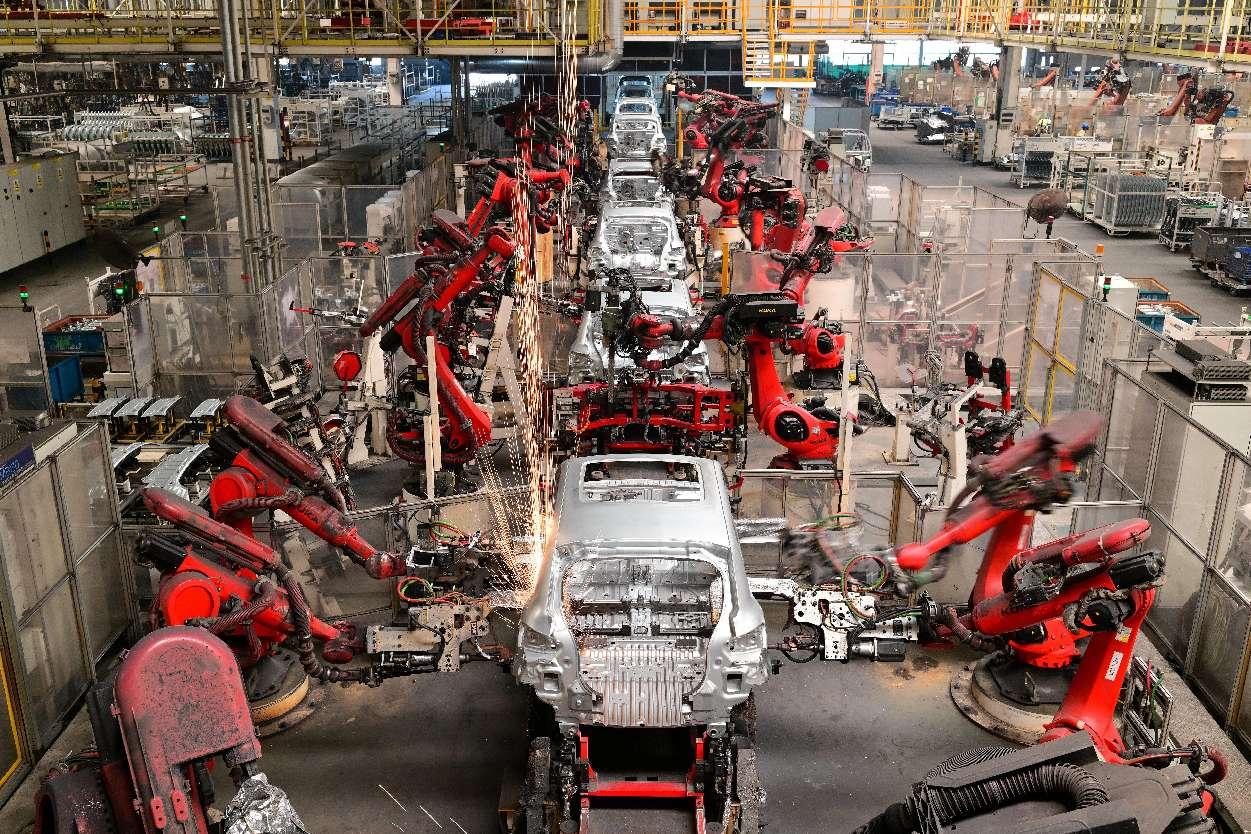Foreign
China’s trade, auto data highlight bright prospects of Chinese economy

By Ren Ping, People’s Daily
Despite the ongoing global economic headwinds, recent data from two key sectors provide compelling evidence of China’s resilient economic trajectory.
On May 12, the China Association of Automobile Manufacturers reported that, for the first time ever, both production and sales of automobiles in China surpassed 10 million units in the first four months of the year, a year-on-year increase of 12.9 percent and 10.8 percent, respectively. Among these, exports of new energy vehicles (NEVs) reached 642,000 units, up 52.6 percent from a year ago.
The robust performance of the auto sector, a strategic and pillar industry, reflects the deeper logic behind China’s high-quality development.
Additionally, customs data released on May 9 showed that China’s total goods imports and exports in yuan-denominated terms expanded 2.4 percent year on year in the first four months of this year. In April alone, China’s foreign trade was up 5.6 percent year on year, with exports rising 9.3 percent.
Despite global uncertainties, particularly in trade, China’s manufacturing and innovation strengths have allowed the country to sustain its economic momentum.
Reuters reported that China’s factory output showed surprising resilience in April, a sign that government support measures may have cushioned the impact of a trade war with the United States.
Together, these data points not only reflect the resilience of the Chinese economy but also its promising outlook for the future.
China’s confidence in tackling risks and challenges stems from effective macroeconomic policy and capable governance.
According to China’s Ministry of Commerce, the total number of applications for auto trade-in subsidies in China exceeded 10 million by May 11, under a mass renewal program initiated in 2024. International media outlets said this program has been particularly effective in counteracting the negative effect of U.S. tariffs on consumer confidence.
Beyond facilitating millions of vehicle upgrades, the program has significantly boosted sales of durable goods. In the first quarter, the policy helped drive a 19 percent year-on-year increase in investment in equipment and tools, and contributed to a 4.6 percent rise in total retail sales of consumer goods.
Moreover, the synergy between technological innovation and industrial upgrading is unlocking new momentum.
China’s auto industry today is experiencing a surge in technological innovation, with major advancements being made in electric vehicle (EV) technology.
For instance, Chinese EV battery giant CATL recently launched a new brand for its sodium-ion battery with a life cycle of over 10,000 charges and performance evenin extreme temperatures as low as minus 40 degrees Celsius. Inside a welding workshop of Chinese automaker Guangzhou Automobile Group Co., Ltd. (GAC Group) in Yichang, cemtral China’sHubei province, over 500 robots work in sync, producing a new car every 52 seconds.
The shift toward high-end, intelligent, and green production is rapidly becoming standard practice. A more dynamic equilibrium — where supply responds to demand and demand drives new supply — has transitioned from a theoretical ideal to practical reality.
At the recently concluded 21st Shanghai International Automobile Industry Exhibition(Auto Shanghai 2025), over 100 new models made their global debut, with over 70 percent being NEVs. Cutting-edge technologies were everywhere at the event. As Germany’s Die Welt commented, anyone visiting Auto Shanghai 2025 would feel that the future has already come to China.
From technology importer to exporter, from attracting investment to making overseas investment, and from adapting to standards to setting them, China is gaining new competitive advantages and expanding its role in global cooperation.
In the first four months of 2024, China’s high-tech exports rose 7.4 percent year on year, accounting for around 20 percent of the country’s total exports and contributing to a 1.3percentage point rise in overall export growth. This thriving “innovation ecosystem” is central to China’s ability to navigate economic cycles and mitigate risks.
Green and low-carbon development is not only a long-term solution to environmental challenges but also a global trend. From January to April, China’s NEV output and sales both exceeded 4 million units, marking a year-on-year growth of over 45 percent.
Chinese NEV manufacturers are intensifying efforts in renewable energy, energy efficiency, material recycling, and technological upgrades to reduce carbon emissions throughout the supply chain. NEVs are now ubiquitous on Chinese streets, and more and more young Chinese are choosing NEVs as their first cars.This symbiotic relationship between green production and green lifestyles is accelerating.
Besides, Chinese manufacturing and global demand are also mutually reinforcing.
In the first quarter of this year, major destinations for Chinese auto exports included Mexico, the United Arab Emirates, Russia, Belgium, Saudi Arabia, Brazil, and Australia. A popular Brazilian auto influencer recently remarked that Chinese NEVs are becoming a new choice for car buyers in Brazil. Ricardo Bastos, president of the Brazilian Association of Electric Vehicles, emphasized: “We need clean energy to replace fossil fuels. This industrial transformation is sweeping the world.”
By embracing the opportunities presented by digital and green transformation and by leveraging both global and domestic markets, Chinese smart manufacturing is not only meeting people’s aspirations for a better life but also playing a pivotal role in the global transition to clean mobility.
Foreign
China launches Tianwen-2 for asteroid sampling

By Yu Sinan, Li Yi, Zhang Wei
In the early hours of May 29, China successfully launched its first asteroid sample-return mission, Tianwen-2, from the Xichang Satellite Launch Center in southwest China’s Sichuan province, an endeavor designed to shed light on the formation and evolution of asteroids and the early solar system.
The Tianwen-2 mission aims to achieve multiple goals over a decade-long expedition: collecting samples from the near-Earth asteroid 2016HO3 and exploring the main-belt comet 311P, which is more distant than Mars.
The mission includes 13 flight stages and will reach a distance of approximately 150 million to 500 million kilometers from Earth, marking a major step forward in China’s deep space exploration endeavors.
Known as a quasi-satellite of Earth, the asteroid 2016HO3 orbits the Sun and appears to circle around Earth as well, remaining a constant companion to our planet. Its relatively stable orbit requires lower energy requirements for spacecraft to reach it, while enabling a viable scenario for subsequent exploration of the main-belt comet 311P.
Scientific research suggests that the asteroid 2016HO3 may preserve primitive materials from the early solar system. Investigating this asteroid could yield valuable insights into the composition, formation, and evolutionary history of the solar system’s early materials.
The second target, 311P, a celestial anomaly discovered in the mainasteroid belt between Mars and Jupiter, occasionally spews out materials and resembles a comet with tails. While it exhibits compositional traits with traditional comets, it maintains the orbital characteristics of an asteroid. Exploring this unique object will deepen human understanding of the composition, structure, and evolutionary mechanisms of small celestial bodies.
Tianwen-1 marked China’s first Mars exploration mission, successfully achieving orbiting, landing, and roving operations in a single mission. Tianwen-2, however, has a different set of objectives and faces new technical challenges.
First, the Tianwen-2 mission will conduct sampling under weak gravity conditions. Observational data suggest that the asteroid 2016HO3, with an average diameter of about 41 meters, exists in near-zero gravity and rotates rapidly. Given these complex conditions, it is extremely challenging for the probe to achieve stable attachment with the asteroid and sampling within a limited time.
Second, the mission involves vast distances. Asteroid 2016HO3 is located about 18 million to 46 million kilometers from Earth, while the main-belt comet 311P lies approximately 150 million to 500 million kilometers away. The immense distance from Earth imposes stringent requirements on the probe’s communication system, trajectory design, power management, and the capability to maintain highly reliable long-term operational performance.
Furthermore, there is uncertainty regarding the exploration target. Current observations of the asteroid 2016HO3 provide limited information on its rotational behavior and surface characteristics, which significantly complicate the design of both the spacecraft and its sampling methods.
Tianwen-2 is equipped with 11 scientific instruments, including cameras, a visible and infrared imaging spectrometer, a thermal emission spectrometer, and a detection radar, all designed to facilitate scientific data collection during the mission.
In previous missions sending payloads into the Earth’s orbit, a rocket is required to achieve a separation velocity equal to the first cosmic velocity, or approximately 7.9 kilometers per second.
However, this mission requires a separation speed exceeding 11.2 kilometers per second, known as the second cosmic velocity, to escape the Earth’s gravitational influence, necessitating high speed and energy.
After evaluating the rocket’s payload capacity, performance capability, and reliability, Long March-3B was chosen as the dedicated vehicle for the Tianwen-2 mission.
As the primary launch vehicle for China’s high-orbit launches, the Long March-3B has completed 108 missions, including key lunar missions such as Chang’e-3 and Chang’e-4.
Experts noted that asteroids are characterized by their small size, low mass, and weak gravity, making them challenging to capture and requiring exceptional precision in the rocket’s trajectory. During this launch, the rocket reached a speed of 11.2 kilometers per second, with a permitted speed deviation of no more than one meter per second, which could otherwise lead to a positional error of up to one million kilometers.
“Achieving such trajectory precision is akin to shooting a basketball from Shanghai to hit a hoop in Beijing, while ensuring the ball’s angle and speed upon entering the hoop are correct,” said Wei Yuanming, an expert with China Aerospace Science and Technology Corporation.
To tackle this challenge, the rocket design team spent two years completing multiple design iterations so as to achieve seamless “handoff” between the rocket and the probe, Wei added.
Foreign
IOMedadvances international rule of law through innovation, improves global governance

By He Yin, People’s Daily
On May 30, the signing ceremony of the Convention on the Establishment of the International Organization for Mediation (IOMed) was held in Hong Kong. High-level representatives from 85 countries across Asia, Africa, Latin America, and Europe, and nearly 20 international organizations attended the event. Among them, 33 countries signed the convention on-site, making them the founding members of the IOMed.
The establishment of the IOMed marks an innovative step in international rule of law and a major initiative by the Global South to jointly promote global governance reforms and improvements. It has great significance in the history of international relations and fully demonstrates China’s commitment to contributing wisdom and solutions to global development and progress.
The establishment of the IOMed is an actualization of the purposes and principles of the UN Charter. It serves as an important public good in the field of the rule of law for better global governance.
Mediation, as is clearly stated in Article 33 of the UN Charter, is one of the first means that should be tried in seeking peaceful solutions to international disputes. However, prior to theIOMed’screation,no dedicatedintergovernmental legal organization existed to addressinternational disputes through mediation.
The IOMed fills this institutional gap by mediating in disputes between states, between states and investors in other countries, and international commercial disputes at the will of all parties. This represents a significant advancement in the development of the international rule of law.
Drawing upon the strengths of major legal systems, the IOMed respects the autonomy of the parties concerned and offers advantages of being more flexible, cost-effective, convenient, and efficient. It complements and forms synergies with litigation, arbitration, and other existing international dispute settlement mechanisms, thereby enhancing their overall effectiveness.
As the world is entering a new period of turbulence and transformation, the global demand for timely and effective conflict resolution and the need to safeguard long-term cooperative relations is growing stronger.
The proposal to establish the IOMed has received broad international support and active response, reflecting China’s consistent commitment to promoting peace and resolving conflicts on the international stage.
From facilitating the reconciliation between Saudi Arabia and Iran in Beijing, to promoting intra-Palestinian reconciliation talks and the signing of the Beijing Declaration on Ending Division and Strengthening Palestinian National Unity, and to playing a constructive role in promoting the political settlement of the Ukraine crisis, the Palestinian-Israeli conflict, and issues related to the Korean Peninsula and Myanmar, China has long maintained that differences should be handled in the spirit of mutual understanding and accommodation. It advocates building consensus through dialogue and consultation, promoting development through win-win cooperation, and solving problems with a vision for the future, offering Chinese wisdom for countries seeking peaceful solutions to conflicts and differences.
The principles of resolving disputes through dialogue and mediating differencesare universally embraced across civilizations. Chinese civilization, deeply rooted in the value of harmony, has long advocated peaceful coexistence. Its legal tradition values reconciliation and the non-violent conflict resolution,which aligns closely with the principles of modern international law for the peaceful settlement of disputes.
The IOMed does not impose binding rulings but instead provides an impartial platform for voluntary negotiation among parties. It upholds the principles of voluntary participation, equal consultation, and mutual benefit, respects the legitimate concerns of all parties, and strives for win-win outcomes, vividly illustrating the wisdom of harmony and peaceful coexistence.
In the long run, the birth of the IOMed can help transcend the “you-lose-I-win”zero-sum mentality, promote the amicable resolution of international disputes, and foster more harmonious international relations.
The IOMed is a legal public good for improving global governance contributed by countries of the Global South. It will make a significant contribution to upholding international equity and justice.
As the trend toward a multipolar world and greater democracy in international relations gathers momentum, the Global South has transformed from a “silent majority” in international politics to an important force in maintaining peace, driving development, and improving global governance.
Countries from the Global South have actively supported and participated in the establishment of the IOMed, widely recognizing it as consistent with the purposes and principles of the UN Charter and reflective of the values of respect, mutual trust, fairness, and harmony. The IOMed is broadly viewed as an effective measure for strengthening multilateralism.
Looking ahead, the organization will uphold the true spirit of the rule of law, strike a balance between procedural justice and substantive justice, expand the participation of developing countries, and steer international dispute settlement mechanisms toward greater equity and inclusiveness, thereby increasing the representation and voice of the Global South in global governance.
The preamble to the UN Charter solemnly states the commitment “to practice tolerance and live together in peace with one another as good neighbors, and to unite our strength to maintain international peace and security.”This aspiration captures the common vision of the international community.
Looking to the future, as long as all parties make good use of mediation and approach disputes with mutual understanding, they can turn conflict into cooperation, replace confrontation with dialogue, and move forward on the path toward building a community with a shared future for mankind.
Foreign
Outdoor activities fuel new growth in rural China

By Zhou Renjie, People’s Daily
During this year’s May Day holiday, outdoor sports and travel captured wide public interest and participation across China.
At Shijiu Lake in Nanjing, east China’s Jiangsu province, a young visitor transitioned from a fishing lure session tostargazing through a telescope.Nestled in the Aba Tibetan and Qiang autonomous prefecture, southwest China’s Sichuan province, the Siguniang Mountain scenic area launched over 10 outdoor adventure routes, including hiking, mountain trekking, and rockclimbing, catering to outdoor enthusiasts of all ages.
In China, over 400 million people engage in outdoor activities. The development of outdoor sports delivers wide-ranging societalbenefits. It fulfills the growing public demand for physical wellness, advances the Chinese national fitness campaign, stimulates associated industries, and presents vast potential for future development.
A growing number of outdoor sports events and leisure experiences are taking root in scenic destinations across the country.
In Shangri-la, southwest China’s Yunnan province, a network of hiking and cycling trails serves as venues for prominent events such as the Tour of Yunnan International Road Cycling Race and the Yunnan Plateau Lakes and Mountains Series.
In Nanxun, Huzhou, east China’s Zhejiang province, visitors enjoy activities ranging from nocturnal fishing and hot-air ballooning to orienteering through ancient towns.
In Chongli, Zhangjiakou, Hebei province in north China, night skiing enables thrill-seekers to race down snow-covered slopes under a star-filled sky, evoking the sensation of flight just above the earth..
These diverse outdoor experiences act as a powerful engine for transforming picturesque natural environments into sources of sustainable economic development.
China is steadily promoting the development of outdoor sports destinations to ensure the timely achievement of its goal to build around 100 high-quality outdoor sports destinations by 2030. With itsvast territory and spectacular landscapes, the country is well-positioned to leverage its world-class natural resources in this endeavor.
Outdoor tourism development also dovetails with China’s comprehensive rural vitalization strategy. In Xishui county, Huanggang, Hubei province, a rural triathlon combining swimming, road cycling, and cross-country running was held. The event catalyzed economic activity, with online and offline sales of agricultural products exceeding 5.8 million yuan ($807,737), a year-on-year surge of 230 percent.
In the scenic Canglu Valley in Yunnan province’sDali Bai autonomous prefecture,surrounded by lush mountains, a tourism development model centered on outdoor leisure and lifestyles attracted more than 70,000 visitors in 2024, generatingaround 3 million yuan in consumption.
Traditionally, rural areas dense with forests, rivers, and mountains weredeemed economically unsuitable for agricultural or industrial development. Today, many of these regions are leveraging their natural endowments to develop premium outdoor destinations, thereby creating new opportunities for local growth.
High-quality outdoor destinations not only stimulate local cultural and tourism development, but also help expand related industries.
The Chinese outdoor apparel industry, for instance, is experiencing rapid growth. In Zhejiang, a “three-hour supply circle” for manufacturing outdoor jackets has emerged: composite fabrics from Jiaojiang in Taizhou, waterproof zippers from Linhai, fleece liners from Keqiao in Shaoxing, and final assembly in Sanmen. This close-knit supply chain exemplifies how the integration of sports and commerce is accelerating industrial synergy, with supply and demand mutually reinforcing.
In the Guangdong-Hong Kong-Macao Greater Bay Area, novice surfers ride the waves under professional guidance. Along the Yellow River, rally races deliver pulse-pounding excitement. In Hubei province, adigital outdoor sports map is enhancing smart infrastructure and services. What were once niche or fringe activities are now becoming part of everyday life.
By turning “small sports” into “big industries,” and combining proactive government support with dynamic market mechanisms, China is turning innovative concepts into tangible benefits.
-

 Foreign14 hours ago
Foreign14 hours agoXinjiang embraces innovation to modernize agriculture
-
Foreign14 hours ago
China’s bearing industry shifts into high gear for high-end development
-

 Foreign8 hours ago
Foreign8 hours agoXinjiang embraces innovation to modernize agriculture
-

 Foreign4 hours ago
Foreign4 hours agoBiodiversity continues to recover in Yangtze river as fishing ban reaches fifth year
-

 Foreign4 hours ago
Foreign4 hours agoHenan advances high-quality development through real economy
-

 Foreign4 hours ago
Foreign4 hours agoASEAN-China-GCC Summit groundbreaking act of solidarity, self-strengthening for global south
-

 Foreign4 hours ago
Foreign4 hours agoWhat makes China ‘cool’
-

 Foreign4 hours ago
Foreign4 hours agoFrom black to green: how Ordos is turning coal lands into a clean energy frontier








